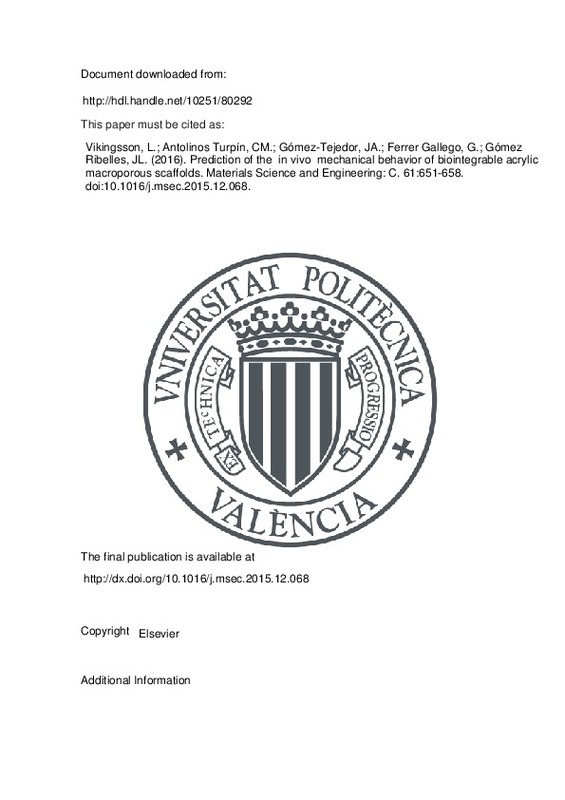JavaScript is disabled for your browser. Some features of this site may not work without it.
Buscar en RiuNet
Listar
Mi cuenta
Estadísticas
Ayuda RiuNet
Admin. UPV
Prediction of the in vivo mechanical behavior of biointegrable acrylic macroporous scaffolds
Mostrar el registro sencillo del ítem
Ficheros en el ítem
| dc.contributor.author | Vikingsson, Line
|
es_ES |
| dc.contributor.author | Antolinos Turpín, Carmen María
|
es_ES |
| dc.contributor.author | Gómez-Tejedor, José Antonio
|
es_ES |
| dc.contributor.author | Gallego-Ferrer, Gloria
|
es_ES |
| dc.contributor.author | Gómez Ribelles, José Luís
|
es_ES |
| dc.date.accessioned | 2017-05-02T08:25:00Z | |
| dc.date.available | 2017-05-02T08:25:00Z | |
| dc.date.issued | 2016-04-01 | |
| dc.identifier.issn | 0928-4931 | |
| dc.identifier.uri | http://hdl.handle.net/10251/80292 | |
| dc.description.abstract | [EN] This study examines a biocompatible scaffold series of random copolymer networks P(EA-HEA) made of Ethyl Acrylate, EA, and 2-Hydroxyl Ethyl Acrylate, HEA. The P(EA-HEA) scaffolds have been synthesized with varying crosslinking density and filled with a Poly(Vinyl Alcohol), PVA, to mimic the growing cartilaginous tissue during tissue repair. In cartilage regeneration the scaffold needs to have sufficient mechanical properties to sustain the compression in the joint and, at the same time, transmit mechanical signals to the cells for chondrogenic differentiation. Mechanical tests show that the elastic modulus increases with increasing crosslinking density of P(EA-HEA) scaffolds. The water plays an important role in the mechanical behavior of the scaffold, but highly depends on the crosslinking density of the proper polymer. Furthermore, when the scaffold with hydrogel is tested it can be seen that the modulus increases with increasing hydrogel density. Even so, the mechanical properties are inferior than those of the scaffolds with water filling the pores. The hydrogel inside the pores of the scaffolds facilitates the expulsion of water during compression and lowers the mechanical modulus of the scaffold. The P(EA-HEA) with PVA shows to be a good artificial cartilage model with mechanical properties close to native articular cartilage. | es_ES |
| dc.description.sponsorship | This work was funded by the Spanish Ministry of Economy and Competitiveness (MINECO) through the project MAT2013-46467-C4-1-R (including the FEDER financial support). CIBER-BBN is an initiative funded by the VI National R&D&i Plan 2008-2011, Iniciativa Ingenio 2010, Consolider Program. CIBER actions are financed by the Instituto de Salud Carlos III with assistance from the European Regional Development Fund. The authors acknowledge the assistance and advice of Electron Microscopy Service of the UPV. | en_EN |
| dc.language | Inglés | es_ES |
| dc.publisher | Elsevier | es_ES |
| dc.relation.ispartof | Materials Science and Engineering: C | es_ES |
| dc.rights | Reserva de todos los derechos | es_ES |
| dc.subject | Poly(ethyl acrylate) (PEA) | es_ES |
| dc.subject | Poly(2-hydroxyl ethyl acrylate) (PHEA) | es_ES |
| dc.subject | Poly(Vinyl Alcohol) | es_ES |
| dc.subject | Freezing and thawing | es_ES |
| dc.subject | Mechanical properties | es_ES |
| dc.subject | Scaffold | es_ES |
| dc.subject | Electron Microscopy Service of the UPV | |
| dc.subject.classification | MAQUINAS Y MOTORES TERMICOS | es_ES |
| dc.subject.classification | FISICA APLICADA | es_ES |
| dc.title | Prediction of the in vivo mechanical behavior of biointegrable acrylic macroporous scaffolds | es_ES |
| dc.type | Artículo | es_ES |
| dc.identifier.doi | 10.1016/j.msec.2015.12.068 | |
| dc.relation.projectID | info:eu-repo/grantAgreement/MINECO//MAT2013-46467-C4-1-R/ES/ESTIMULACION MECANICA LOCAL DE CELULAS MESENQUIMALES DE CARA A SU DIFERENCIACION OSTEOGENICA Y CONDROGENICA EN MEDICINA REGENERATIVA/ | es_ES |
| dc.rights.accessRights | Abierto | es_ES |
| dc.contributor.affiliation | Universitat Politècnica de València. Escuela Técnica Superior de Ingenieros Industriales - Escola Tècnica Superior d'Enginyers Industrials | es_ES |
| dc.contributor.affiliation | Universitat Politècnica de València. Escuela Técnica Superior de Ingeniería del Diseño - Escola Tècnica Superior d'Enginyeria del Disseny | es_ES |
| dc.description.bibliographicCitation | Vikingsson, L.; Antolinos Turpín, CM.; Gómez-Tejedor, JA.; Gallego-Ferrer, G.; Gómez Ribelles, JL. (2016). Prediction of the in vivo mechanical behavior of biointegrable acrylic macroporous scaffolds. Materials Science and Engineering: C. 61:651-658. https://doi.org/10.1016/j.msec.2015.12.068 | es_ES |
| dc.description.accrualMethod | S | es_ES |
| dc.relation.publisherversion | http://dx.doi.org/10.1016/j.msec.2015.12.068 | es_ES |
| dc.description.upvformatpinicio | 651 | es_ES |
| dc.description.upvformatpfin | 658 | es_ES |
| dc.type.version | info:eu-repo/semantics/publishedVersion | es_ES |
| dc.description.volume | 61 | es_ES |
| dc.relation.senia | 299174 | es_ES |
| dc.contributor.funder | Instituto de Salud Carlos III | |
| dc.contributor.funder | Ministerio de Economía y Competitividad |







![[Cerrado]](/themes/UPV/images/candado.png)

